 |
 |
         |
Then felt I like some watcher of the skies when a new planet swims into his ken. - John Keats
Colorful latitudinal bands, atmospheric clouds and storms illustrate Jupiter's dynamic weather systems. The cloud patterns change within hours or days. The Great Red Spot is a complex storm moving in a counter-clockwise direction. At the outer edge, material appears to rotate in four to six days; near the center, motions are small and nearly random in direction. An array of other smaller storms and eddies can be found through out the banded clouds.
Auroral emissions, similar to Earth's northern lights, were observed in the polar regions of Jupiter. The auroral emissions appear to be related to material from Io that spirals along magnetic field lines to fall into Jupiter's atmosphere. Cloud-top lightning bolts, similar to superbolts in Earth's high atmosphere, were also observed.
Unlike Saturn's intricate and complex ring patterns, Jupiter has a simple ring system that is composed of an inner halo, a main ring and a Gossamer ring. To the Voyager spacecraft, the Gossamer ring appeared to be a single ring, but Galileo imagery provided the unexpected discovery that Gossamer is really two rings. One ring is embedded within the other. The rings are very tenuous and are composed of dust particles kicked up as interplanetary meteoroids smash into Jupiter's four small inner moons Metis, Adrastea, Thebe, and Amalthea. Many of the particles are microscopic in size.
The innermost halo ring is toroidal in shape and extends radially from about 92,000 kilometers (57,000 miles) to about 122,500 kilometers (76,000 miles) from Jupiter's center. It is formed as fine particles of dust from the main ring's inner boundary 'bloom' outward as they fall toward the planet. The main and brightest ring extends from the halo boundary out to about 128,940 kilometers (80,000 miles) or just inside the orbit of Adrastea. Close to the orbit of Metis, the main ring's brightness decreases.
The two faint Gossamer rings are fairly uniform in nature. The innermost Amalthea Gossamer ring extends from the orbit of Adrastea out to the orbit of Amalthea at 181,000 kilometers (112,000 miles) from Jupiter's center. The fainter Thebe Gossamer ring extends from Amalthea's orbit out to about Thebe's orbit at 221,000 kilometers (136,000 miles).
Jupiter's rings and moons exist within an intense radiation belt of electrons and ions trapped in the planet's magnetic field. These particles and fields comprise the jovian magnetosphere or magnetic environment, which extends 3 to 7 million kilometers (1.9 to 4.3 million miles) toward the Sun, and stretches in a windsock shape at least as far as Saturn's orbit - a distance of 750 million kilometers (466 million miles).
| Jupiter Statistics | |
|---|---|
| Mass (kg) | 1.900e+27 |
| Mass (Earth = 1) | 3.1794e+02 |
| Equatorial radius (km) | 71,492 |
| Equatorial radius (Earth = 1) | 1.1209e+01 |
| Mean density (gm/cm^3) | 1.33 |
| Mean distance from the Sun (km) | 778,330,000 |
| Mean distance from the Sun (Earth = 1) | 5.2028 |
| Rotational period (days) | 0.41354 |
| Orbital period (days) | 4332.71 |
| Mean orbital velocity (km/sec) | 13.07 |
| Orbital eccentricity | 0.0483 |
| Tilt of axis (degrees) | 3.13 |
| Orbital inclination (degrees) | 1.308 |
| Equatorial surface gravity (m/sec^2) | 22.88 |
| Equatorial escape velocity (km/sec) | 59.56 |
| Visual geometric albedo | 0.52 |
| Magnitude (Vo) | -2.70 |
| Mean cloud temperature | -121°C |
| Atmospheric pressure (bars) | 0.7 |
| Atmospheric composition
|
90% 10% |
| Animations of Jupiter |
|---|
| Views of Jupiter |
|---|
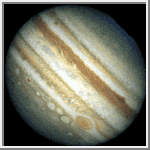 Jupiter
Jupiter
This image was taken by NASA's Hubble Space
Telescope on February 13, 1995. The image provides a detailed look at a unique
cluster of three white oval-shaped storms that lie southwest (below and to the
left) of Jupiter's Great Red Spot. The appearance of the clouds, in this image,
is considerably different from their appearance only seven months earlier. These
features are moving closer together as the Great Red Spot is carried westward by
the prevailing winds while the white ovals are swept eastward.
The outer two of the white storms formed in the late 1930s. In the centers of
these cloud systems the air is rising, carrying fresh ammonia gas upward. New,
white ice crystals form when the upwelling gas freezes as it reaches the chilly
cloud top level where temperatures are -130°C (-200°F). The intervening white
storm center, the ropy structure to the left of the ovals, and the small brown
spot have formed in low pressure cells. The white clouds sit above locations
where gas is descending to lower, warmer regions. 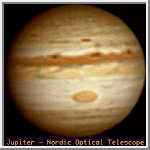 Nordic Optical Telescope
Nordic Optical Telescope
This image of Jupiter was taken with the 2.6
meter Nordic Optical
Telescope, located at La Palma, Canary Islands. It is a good example of the
best imagery that can be obtained from earth based telescopes. (c) Nordic
Optical Telescope Scientific Association (NOTSA). 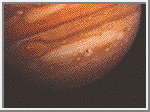 Jupiter with Satellites Io and Europa
Jupiter with Satellites Io and Europa
Voyager 1 took this photo
of Jupiter and two of its satellites (Io, left, and Europa, right) on Feb. 13,
1979. In this view, Io is about 350,000 kilometers (220,000 miles) above
Jupiter's Great Red Spot, while Europa is about 600,000 kilometers (373,000
miles) above Jupiter's clouds. Jupiter is about 20 million kilometers (12.4
million miles) from the spacecraft at the time of this photo. There is evidence
of circular motion in Jupiter's atmosphere. While the dominant large scale
motions are west-to-east, small scale movement includes eddy like circulation
within and between the bands. (Courtesy NASA/JPL)  Satellite Footprints Seen in Jupiter Aurora
Satellite Footprints Seen in Jupiter Aurora
In this Hubble Space
Telescope picture, a curtain of glowing gas is wrapped around Jupiter's north
pole like a lasso. This curtain of light, called an aurora, is produced when
high-energy electrons race along the planet's magnetic field and into the upper
atmosphere where they excite atmospheric gases, causing them to glow. The aurora
resembles the same phenomenon that crowns Earth's polar regions. But this Hubble
image, taken in ultraviolet light, also shows the glowing "footprints" of three
of Jupiter's largest moons: Io, Ganymede, and Europa.
Courtesy of NASA/ESA, John Clarke (University of Michigan) 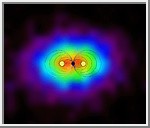 Jupiter's
Magnetosphere
Jupiter's
Magnetosphere
This image taken by the ion and neutral mass spectrometer
instrument on NASA's Cassini spacecraft makes the huge magnetosphere surrounding
Jupiter visible in a way no instrument on any previous spacecraft has been able
to do. The magnetosphere is a bubble of charged particles trapped within the
magnetic environment of the planet. A magnetic field is sketched over the image
to place the energetic neutral atom emissions in perspective. This sketch
extends in the horizontal plane to a width 30 times the radius of Jupiter. Also
shown for scale and location are the disk of Jupiter (black circle) and the
approximate position (yellow circles) of the doughnut-shaped torus created from
material spewed out by volcanoes on Io.
Some of the fast-moving ions within the magnetosphere pick up electrons to
become neutral atoms, and once they become neutral, they can escape Jupiter's
magnetic field, flying out from the magnetosphere at speeds of thousands of
kilometers, or miles, per second. 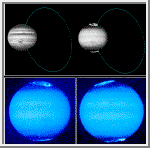 Jupiter's Auroras
Jupiter's Auroras
These HST images, reveal changes in Jupiter's
auroral emissions and how small auroral spots just outside the emission rings
are linked to the planet's volcanic moon, Io. The top panel pinpoints the
effects of emissions from Io. The image on the left, shows how Io and Jupiter
are linked by an invisible electrical current of charged particles called a
flux tube. The particles, ejected from Io by volcanic eruptions, flow
along Jupiter's magnetic field lines, which thread through Io, to the planet's
north and south magnetic poles.
The top-right image shows Jupiter's auroral emissions at the north and south poles. Just outside these emissions are the auroral spots called "footprints." The spots are created when the particles in Io's "flux tube" reach Jupiter's upper atmosphere and interact with hydrogen gas, making it fluoresce.
The two ultraviolet images at the bottom of the picture show how the auroral emissions change in brightness and structure as Jupiter rotates. These false-color images also reveal how the magnetic field is offset from Jupiter's spin axis by 10 to 15 degrees. In the right image, the north auroral emission is rising over the left limb; the south auroral oval is beginning to set. The image on the left, obtained on a different date, shows a full view of the north aurora, with a strong emission inside the main auroral oval.
Credits: John T. Clarke and Gilda E. Ballester (University of Michigan),
John Trauger and Robin Evans (Jet Propulsion Laboratory), and NASA. 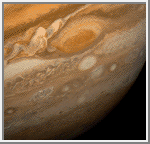 The Great
Red Spot
The Great
Red Spot
This dramatic view of Jupiter's Great Red Spot and its
surroundings was obtained by Voyager 1 on Feb. 25, 1979, when the spacecraft was
9.2 million kilometers (5.7 million miles) from Jupiter. Cloud details as small
as 160 kilometers (100 miles) across can be seen here. The colorful, wavy cloud
pattern to the left of the Red Spot is a region of extraordinarily complex and
variable wave motion. (Courtesy NASA)  False Color of Jupiter's Great Red Spot
False Color of Jupiter's Great Red Spot
This image is a false color
representation of Jupiter's Great Red Spot taken with Galileo's imaging system
through three different near-infrared filters. This is a mosaic of eighteen
images (6 in each filter) that were taken over a period of 6 minutes on June 26,
1996. The Great Red Spot appears pink and the surrounding region blue because of
the particular color coding used in this representation. The red channel is the
reflectance of Jupiter at a wavelength where methane strongly absorbs (889nm).
Because of this absorption, only high clouds can reflect sunlight in this
wavelength. The green channel is the reflectance in a wavelength where methane
absorbs, but less strongly (727nm). Lower clouds can reflect sunlight in this
wavelength. Finally, the blue channel is the reflectance in a wavelength where
there are essentially no absorbers in the Jovian atmosphere (756nm) and one sees
light reflected from the deepest clouds. Thus, the color of a cloud in this
image indicates its height, with red or white being highest and blue or black
being lowest. This image shows the Great Red Spot to be relatively high, as are
some smaller clouds to the northeast and northwest that are surprisingly like
towering thunderstorms found on earth. The deepest clouds are in the collar
surrounding the Great Red Spot, and also just to the northwest of the high
(bright) cloud in the northwest corner of the image. Preliminary modelling shows
these cloud heights to range about 50km in altitude. (Courtesy NASA/JPL)
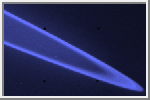 Ring of
Jupiter
Ring of
Jupiter
The ring of Jupiter was discovered by Voyager 1 in March of
1979. This image was taken by Voyager 2 and has been pseudo colored. The Jovian
ring is about 6,500 kilometers (4,000 miles) wide and probably less than 10
kilometers (6.2 miles) thick. (Copyright Calvin J. Hamilton) 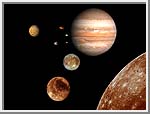 The Jupiter System
The Jupiter System
The best of the Jupiter system is pictured in this collage of images
acquired by the Voyager and Galileo spacecraft. Jupiter is the largest planet in
our solar system. The four largest moons of Jupiter are known as the Galilean
moons and are named Callisto, Ganymede, Europa, and Io. Inside the orbits of the
Galilean moons are Thebe,
Amalthea, Adrastea, and Metis. At the lower right is
shown the Valhalla region of Callisto. Ganymede is toward the bottom middle.
Europa is a little above and to the right of Ganymede. Io is the top, left-most
moon. Between Io and Jupiter are four little moons. The top-most little moon is
Amalthea. Below and to the right of Amalthea are Metis and Adrastea. To the left
of Adrastea is Thebe. (Copyright Calvin J. Hamilton) 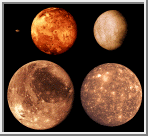 Moons of Jupiter
Moons of Jupiter
This image shows to scale Jupiter's moons Amalthea, Io, Europa, Ganymede, and Callisto. (Copyright
Calvin J. Hamilton)
| Rings of Jupiter |
|---|
| Name | Distance* | Width | Thickness | Mass | Albedo |
|---|---|---|---|---|---|
| Halo | 92,000 km | 30,500 km | 20,000 km | ? | 0.05 |
| Main | 122,500 km | 6,440 km | < 30 km | 1 x 10^13 kg | 0.05 |
| Inner Gossamer | 128,940 km | 52,060 km | ? | ? | 0.05 |
| Outer Gossamer | 181,000 km | 40,000 km | ? | ? | 0.05 |
*The distance is measured from the planet center to the start of the ring.
| Jupiter's Moon Summary |
|---|
Nearly four centuries ago Galileo Galilei turned his homemade telescope towards the heavens and discovered three points of light, which at first he thought to be stars, hugging the planet Jupiter. These stars were arranged in a straight line with Jupiter. Sparking his interest, Galileo observed the stars and found that they moved the wrong way. Four days later another star appeared. After observing the stars over the next few weeks, Galileo concluded that they were not stars but planetary bodies in orbit around Jupiter. These four stars have come to be know as the Galilean satellites.
Over the course of the following centuries another 12 moons were discovered bringing the total to 16. Finally in 1979, the strangeness of these frozen new worlds was brought to light by the Voyager spacecrafts as they swept past the Jovian system. Again in 1996, the exploration of these worlds took a large step forward as the Galileo spacecraft began its long term mission of observing Jupiter and its moons.
Twelve of Jupiter's moons are relatively small and seem to have been more likely captured than to have been formed in orbit around Jupiter. The four large Galilean moons, Io, Europa, Ganymede and Callisto, are believed to have accreted as part of the process by which Jupiter itself formed. The following table summarizes the radius, mass, distance from the planet center, discoverer and the date of discovery of each of the moons of Jupiter:
| Moon | # | Radius (km) | Mass (kg) | Distance (km) | Discoverer | Date |
|---|---|---|---|---|---|---|
| Metis | XVI | 20 | 9.56e+16 | 127,969 | S. Synnott | 1979 |
| Adrastea | XV | 12.5x10x7.5 | 1.91e+16 | 128,971 | Jewitt-Danielson | 1979 |
| Amalthea | V | 135x84x75 | 7.17e+18 | 181,300 | E. Barnard | 1892 |
| Thebe | XIV | 55x45 | 7.77e+17 | 221,895 | S. Synnott | 1979 |
| Io | I | 1,815 | 8.94e+22 | 421,600 | Marius-Galileo | 1610 |
| Europa | II | 1,569 | 4.80e+22 | 670,900 | Marius-Galileo | 1610 |
| Ganymede | III | 2,631 | 1.48e+23 | 1,070,000 | Marius-Galileo | 1610 |
| Callisto | IV | 2,400 | 1.08e+23 | 1,883,000 | Marius-Galileo | 1610 |
| Leda | XIII | 8 | 5.68e+15 | 11,094,000 | C. Kowal | 1974 |
| Himalia | VI | 93 | 9.56e+18 | 11,480,000 | C. Perrine | 1904 |
| Lysithea | X | 18 | 7.77e+16 | 11,720,000 | S. Nicholson | 1938 |
| Elara | VII | 38 | 7.77e+17 | 11,737,000 | C. Perrine | 1905 |
| Ananke | XII | 15 | 3.82e+16 | 21,200,000 | S. Nicholson | 1951 |
| Carme | XI | 20 | 9.56e+16 | 22,600,000 | S. Nicholson | 1938 |
| Pasiphae | VIII | 25 | 1.91e+17 | 23,500,000 | P. Melotte | 1908 |
| Sinope | IX | 18 | 7.77e+16 | 23,700,000 | S. Nicholson | 1914 |

 Return to Mars
Return to Mars  Voyage to Saturn
Voyage to Saturn
Copyright © 1997-2001 by Calvin J. Hamilton. All rights reserved. Privacy Statement.